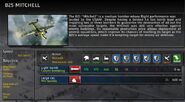| “ | General, the B-25 bombers are fueled and ready in the airfield. - Andrew Campbell, Battle of Monte Cassino |
” |
The B-25 Mitchell is a light bomber whose flight performance was lauded by the USAAF. Despite having a 1.4 ton bomb load and requiring two or three bombers to guarantee the destruction of all but the most vulnerable targets, the Mitchell is still very effective against enemy buildings. Its reasonable production price allows deployment of several squadrons, which improve its chances of reaching its target as the B-25's average speed make it a tempting target for enemy air defenses.
History[]
The North American B-25 Mitchell owed its beginnings to the Army's quest for a medium bomber. The B-18 "Bolo" was designed and built by Douglas Aircraft in 1937 and North American responded to this by designing and building the larger and more powerful B-21 "Dragon" that same year. Both of these aircraft were twin engine "tail dragger" types. Unsatisfied with performance only marginally better than single engine aircraft, the US Army Air Corps issued Proposal Circular #38-385 which was sent to all major aircraft manufacturers in March 1938. It contained the requirements for an "Aircraft - Bombardment Type - Medium". This would fill a gap in the bombing aircraft types between the light bomber and four engine heavy bomber. A total of 5 manufacturers submitted designs (North American, Douglas, Martin, Stearman and Bell) and all but one built prototypes.
North American submitted their "Design NA-40" to the USAAC and shortly afterward built the NA-40B prototype. It was a sleek looking twin engine, twin tail machine with tricycle landing gear, not unlike the B-25 and fairly bristling with .30 Cal. (7.62 mm) machine guns. Unfortunately, while undergoing simulated "engine out" tests, the pilot lost control and the aircraft crashed. The pilot and crew escaped with minor injuries but the NA-40B was destroyed by fire and North American was disqualified, though the Army deemed the accident caused by pilot error and not by anything inherent in the design of the NA-40B. That left only 3 prototypes competing and shortly, one of these also crashed and burned (the Douglas 7B) and was disqualified, leaving less than half the original bidders still competing. The USAAC ruled no contest, and though Glenn Martin raised vigorous objections, new bids were ordered to be submitted in April, 1939.
Strategy[]
This section is a stub, so be patient and expand it.
Pros & Cons[]
Weapons[]
| Weapon | ||||||||||
|---|---|---|---|---|---|---|---|---|---|---|
Light Carpet Bomb |
179 | 179 | 446 | 36 | 18 | 9 | 4 | 2 | 0m |
| Weapon | ||||||||||
|---|---|---|---|---|---|---|---|---|---|---|
Large Cal. MG |
24 | 400m |
Notes[]
- The B-25 and it's upgrade, the B-17, is one of the only instances in the game where upgrading a unit grants the player a earlier model instead of a more modern one.

